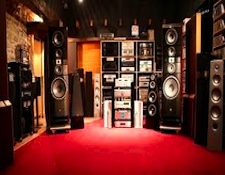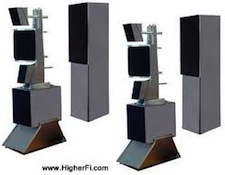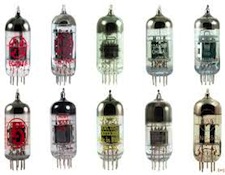It’s the time of year for saving money!
Many a long year ago, I and my Hi-Fi Crazy pals noticed that “Mid-Fi” audio gear could be instantly spotted by its abundance of “features” (knobs, dials, lights, controls and functions, for whatever purpose) and that the cheaper it was, the more of such stuff it was likely to have. We noticed, also, that High-End gear was exactly the opposite – the more you paid for it, the less it was likely to do.
 High End audio usually had no “bells and whistles” at all, and often, though generally offering very high performance, was simple to the point of austerity. Tone controls were, of course, out of the question, as was “loudness” compensation, and a REALLY expensive preamp (there were no High End integrated amps or receivers at the time, so preamps were about the only place where whatever “features” there were would be found) might not even have a “balance” control. On its ascetically bare faceplate there might be nothing more than a selector switch, a volume control, and one tiny pilot light.
High End audio usually had no “bells and whistles” at all, and often, though generally offering very high performance, was simple to the point of austerity. Tone controls were, of course, out of the question, as was “loudness” compensation, and a REALLY expensive preamp (there were no High End integrated amps or receivers at the time, so preamps were about the only place where whatever “features” there were would be found) might not even have a “balance” control. On its ascetically bare faceplate there might be nothing more than a selector switch, a volume control, and one tiny pilot light.
The reason for all this was “purity” – doing as little as possible to modify, distort, or change the recorded signal in any way, and thus to maintain the greatest possible fidelity to the original musical performance.
“High Fidelity” was what the term “Hi-Fi” was derived from, and we were quite serious in our goal of achieving it. That was why we (even before the appearance of the term “High End”) allowed no tone controls or anything else that might change what our equipment sounded like, even if that change might have made an obvious improvement. The reason, of course, was that any improvement we might make other than by actually getting new equipment or modifying (new caps, deluxe resistors, changed internal wiring, etc.) what we already had was seen by us as “cheating” — somehow violating the spirit of our “quest” by using cheap tricks instead of “honorable” (and expensive) new (or newly modified) gear.
 We believed then, as a great many audiophiles still do today, that a really good system – the system that we all aspired someday to own — should NEED no help, either from tone controls or from anything else, (including “surround sound” or other electronic or acoustic tricks), in order to make good and realistic sound. That’s why, if our system’s bass was weak or its treble sounded like it was playing through a pile of pillows, or it’s imaging or soundstaging were less than inspiring, we would rather buy better or newer gear – a subwoofer, perhaps, or some of those (admittedly yummy) new bolt-on viciously expensive electrostatic super-tweeters, or new whatever it was that might be called for – than to simply turn up a tone control or to cheat with some other kind of (easy but somehow not “honorable”) knob or dial.
We believed then, as a great many audiophiles still do today, that a really good system – the system that we all aspired someday to own — should NEED no help, either from tone controls or from anything else, (including “surround sound” or other electronic or acoustic tricks), in order to make good and realistic sound. That’s why, if our system’s bass was weak or its treble sounded like it was playing through a pile of pillows, or it’s imaging or soundstaging were less than inspiring, we would rather buy better or newer gear – a subwoofer, perhaps, or some of those (admittedly yummy) new bolt-on viciously expensive electrostatic super-tweeters, or new whatever it was that might be called for – than to simply turn up a tone control or to cheat with some other kind of (easy but somehow not “honorable”) knob or dial.
That’s all well and good and, as far as it goes, it’s still true today, but, just as for every Dr. Jekyll there’s a Mr. Hyde, so also in the heart of even the most crazed-purist audiophile there lurks “NEVE-MAN”; the guy who knows that the very best – the very purest and very highest fidelity — recordings are made in two-channels, either direct-to-disc or direct-to-tape, using only two microphones, no equalization or “echo” at all, and no post-production “mastering”, but who has, despite all that, seen pictures of the other side of the Force: a studio mixing console with an apparent infinity of channels, inputs, equalizers, “phasers”, “flangers”, effects, knobs, dials, slide-pots, and other instruments of infinite control, and has lusted after it ever since.
There’s an apparent paradox in at least some part of the High End audiophile community. While we believe wholeheartedly that audio must be “pure”, and that to diddle with it is cheating, we also welcome and rejoice in such diddling if it’s sufficiently expensive or done in the “right” way.
 More than two decades ago (if I recall correctly) buyers of the then-possibly-most-expensive-speaker system-in-the-world, the Wilson WAMM, found nothing at all wrong with the fact that WITH the speakers came a Crown professional equalizer (a glorified kind of tone control) that David Wilson would use to tune the speakers to the buyer’s own specific listening room. It was all taken as part of the service and nobody saw it as “cheating” at all.
More than two decades ago (if I recall correctly) buyers of the then-possibly-most-expensive-speaker system-in-the-world, the Wilson WAMM, found nothing at all wrong with the fact that WITH the speakers came a Crown professional equalizer (a glorified kind of tone control) that David Wilson would use to tune the speakers to the buyer’s own specific listening room. It was all taken as part of the service and nobody saw it as “cheating” at all.
David Wilson did it manually, back then, and if the company’s policy about him personally installing their top-of-the-line speakers still holds true, he may still do it now, but since that time any number of computer-controlled automatic devices have hit the market that may even do a better job of it and may, in addition to just frequency-response, correct for other things (room reflections, group delay, etc.) as well.
The process just mentioned is known as Digital Room Correction (“DRC”), and devices and programs to effect it are available in a broad range of hardware and software formats, at prices ranging from relatively inexpensive to many thousands of dollars.
DRC is not the only kind of system diddling that modern audiophiles seem not to consider cheating. One of the most common others, at least among Tube Crazies (an affectionate term not unlike “Hi-Fi Crazies”, which, as you have seen, I regularly apply to myself and my friends), is “Tube Rolling”, the practice of selectively changing brands of (usually) the same tube in a piece of gear in order to obtain a desired sonic outcome.
 As I learned, probably in 1990, when I reviewed a pair of tube preamps for the magazine I was then writing for, changing the tubes (back then it was from Chinese to Russian 12AX7s) can make a COLOSSAL difference in everything from the imaging and soundstaging, to the detail, to the overall bright/dark coloration of a piece of gear, and by proper selection, a skillful or lucky audiophile can make his system sound – within limits, of course – just about any way he wants it to.
As I learned, probably in 1990, when I reviewed a pair of tube preamps for the magazine I was then writing for, changing the tubes (back then it was from Chinese to Russian 12AX7s) can make a COLOSSAL difference in everything from the imaging and soundstaging, to the detail, to the overall bright/dark coloration of a piece of gear, and by proper selection, a skillful or lucky audiophile can make his system sound – within limits, of course – just about any way he wants it to.
The same thing can also be done, to almost the same degree by changing cables; by changing from one kind or brand or model of electronics or phono cartridge to another; and, HUGELY, by changing speakers. All of those things – apparently like DSC – are considered to be “corrections” or “updates” or “mods” (short for “modifications”) and NOT to be “cheating”, even by the most pure of Purists. Even extensive acoustic treatment and “real” (as opposed to DSC) room modification is, for High End audiophiles, perhaps because it’s not actually a part of the system, considered just to be another form of “correction”.
Maybe it’s gotten to the point where only sonic change that comes about by flipping a switch or turning a knob or a dial is still considered to be cheating. Is that possible? What do you think?





